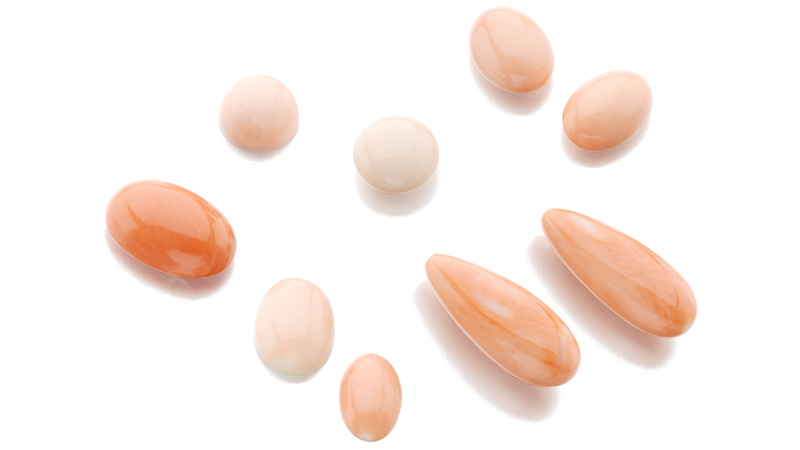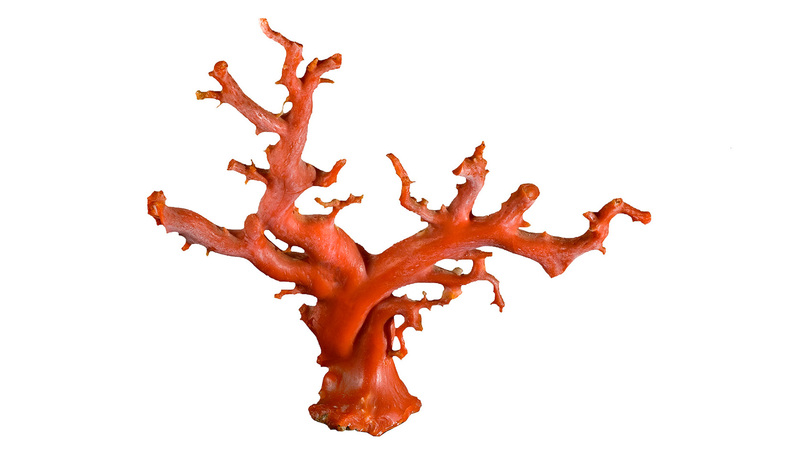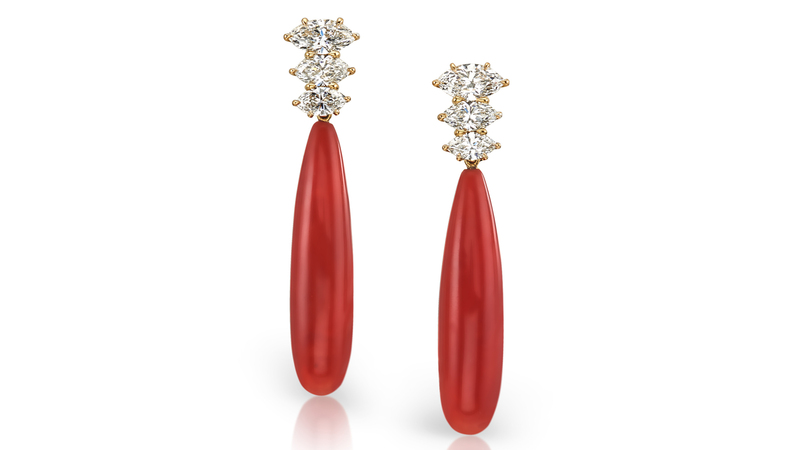5 Things to Know About … Coral

Loose Sardinian coral beads from Assael
"Coral is one of the oldest materials used by humans to adorn their bodies, offering vibrant pops of color in jewels dating all the way back to antiquity.
But, as is the case with most materials used for adornment, there’s a lot to learn about coral—the proper nomenclature, classification, how it’s protected, and more.
In an effort to offer clarity on the subject and an appreciation for the beauty and complexity of coral, here are five things to know about it.
1. It’s important to distinguish among the types of coral.
Nomenclature is an important conversation in many facets of the industry and coral is no exception, so I want to start here.
Corals are, as we know, tiny marine polyps—spineless organisms with a soft body and external skeleton made of calcium carbonate, according to GIA. The animals belong to the Cnidaria phylum, which includes more than 9,000 species.
But coral is a huge, diverse group, and comparing them would be like comparing all mammals, gemologist, gem education consultant, and coral expert Rui Galopim de Carvalho said in a recent interview.
Per the CIBJO Coral Blue Book, the trade defines “precious” corals as those used in jewelry that belong to one taxonomical group: the Corallidae family. Specifically, they are from the genus Corallium, Pleurocorallium, and Hemicorallium.
Fewer than a dozen coral types are considered precious, according to de Carvalho. (A comprehensive list of them is available on the Gem-A website.)

Outside of the Corallidae family, there are a few other coral types occasionally used for decoration.
Referred to as common corals, they are mostly calcareous types and frequently need treatments like bleaching, dyeing or impregnation to be used as gems, he added.
Within that are those biologically know as reef corals, which is what might first come to mind when talking about coral—the colorful coral reefs in shallow waters that can be admired while snorkeling.
Reef corals, which are most affected by climate change and ocean acidification, grow in warm, clear, shallow water.
Precious corals, meanwhile, are solitary or colonial in habit, Gem-A President Maggie Campbell Pedersen wrote in a 2017 article, adding that they grow at greater depths, making them less vulnerable to changes in water temperature.
Precious coral is generally located and harvested 50 meters or more below the surface (one exception is the harvesting of Mediterranean coral) and belongs to a different ecosystem than reef-building coral.
Precious coral is fished in such a way—when done legally and responsibly—that it doesn't destroy the environment, according to CIBJO.
(It’s worth noting that academics use the term “precious” to refer to coral of any type or species that has been used for decoration, regardless of where and how it grows. This means different sources could be talking about different groups of coral.)
2. Here’s what you should know about how coral is regulated.
Endangered and threatened species are protected by an international treaty called CITES. It aims to ensure international trade doesn’t threaten a wild animal or plant’s survival.
Within CITES, species are listed in three Appendices, according to the degree of protection they need.
Appendix I includes species threatened with extinction; trade in those species is prohibited except for exceptional circumstances.
Appendix II includes species that aren’t necessarily threatened with extinction but may become so unless trade is closely controlled. This requires trade be monitored and meticulously documented with strict regulations.

Appendix III lists species for which a country that already regulates its trade is asking for help in controlling it internationally to prevent exploitation. The main objective here is monitoring and resource management.
For Appendices I and II, species can be added, removed, or moved between the two lists only at a conference involving all parties, but they can be added to or removed from Appendix III at any time.
De Carvalho said there is no precious coral currently listed in Appendix I or Appendix II.
He did note that blue coral (Heliopora coerulea)—not classified as precious by the trade but sometimes used in jewelry—is listed in Appendix II.
Precious corals listed in Appendix III includes the deep-red Corallium japonicum, (also known as aka or “oxblood” coral), Pleurocorallium elatius (Angel Skin is a member of this species), Pleurocorallium konojoi, and Pleurocorallium secundum.
3. Precious coral offers a handful of colors.
The corals considered precious by the trade are rare, beautiful, have a uniform color, and a porcelain-like luster after polishing.
They also have a historical significance, de Carvalho said.
For example, Mediterranean coral has been used for thousands of years and is featured in old scriptures.
According to GIA, coral also has a rich lore—Ancient Romans believed it calmed the ocean waves, while in the Victorian era, coral beads were worn to ward off evil spirits.
Gemologically, precious corals are primarily comprised of calcium carbonate, making them relatively durable (they have a hardness of 3 on the Mohs scale, though, so are still soft compared to most gem materials), and can occasionally have a very strong color, which increases their attractiveness.
But the strong red that can be seen fine Mediterranean coral, for example, is just one of a handful of colors available from precious coral.
There’s also pink/salmon, white, cream, and various shades of orange.
4. Here’s what the market typically looks for.
Among the most valued types of coral in the trade is Angel Skin, the light pink variety of P. elatius, which gets its color from an albino-like disorder, de Carvalho wrote in a recent blog post on Assael’s website.
Peggy Grosz, senior vice president of Assael, which sources coral responsibly for its jewels, said: “Matching is critical in a strand or a necklace, not only in color but also in quality. And when you consider the rarity of Angel Skin coral, it is truly a treasure to have an entire strand.”
She said that unlike nacreous pearls, a well-matched Angel Skin coral necklace would almost always need to come from the same source material, so if there’s enough of it, it wouldn’t take as long as matching a gem-quality South Sea pearl necklace, for example.
There’s also the traditional species from the Mediterranean and the adjacent Atlantic Ocean, Corallium rubrum, referred to as Sardinian coral or Mediterranean coral and most desired in its strong red form.
Fishing for these corals now is heavily regulated by the U.N.’s General Fisheries Commission for the Mediterranean.
Harvesting below 50 meters is limited to minimum trunk sizes and only to very experienced divers, de Carvalho wrote.
Japanese aka coral is also among some of the finest, according to De Carvalho, which the trade often calls “oxblood.”
It’s very valuable, especially in its deep red colors, so much so that Chinese consumers normally buy it up before it can even reach the European or North American markets.
Assael, which carries both Angel Skin and Mediterranean coral, has seen demand for coral grow as desire for rare materials increases.
Grosz said more people are learning the differences between precious and reef coral as they aim to educate themselves, especially given that more of the major luxury houses are using precious coral in their new jewelry collections.
Increased demand has driven up prices for coral, she said.
And, as is usually the case, prices are higher for larger pieces of coral, with Grosz noting branches that are thick and/or wide are “few and far between.”

5. Here are resources to make sure you have the right information and rules.
It’s important for the trade to understand coral so they can help communicate clearly their decision to use, or not use, the material.
“At least with the right information people can decide whether to buy or not to buy coral jewelry,” de Carvalho said.
CIBJO has had a Coral Commission since 2014. Both de Carvalho and Assael President and CEO Christina Lang Assael sit on it.
The commission aims to research and talk about conservation and sustainability, as well as to inform the jewelry industry about coral regulations.
CIBJO created a Coral Blue Book, which gives a comprehensive look at the correct terms to be used, what the trade needs to know about coral types, and the regulations they should keep in mind if they decide to buy or sell coral.
Keep in mind import/export rules for where a business is based.
In the U.S., coral is subject to regulations; these requirements include ... "
https://www.nationaljeweler.com/article ... bout-coral